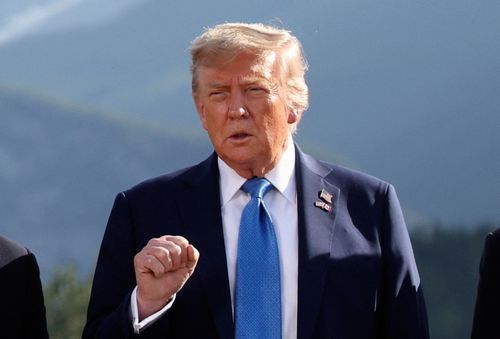Share this @internewscast.com
This debate has overshadowed an equally crucial issue that should have been addressed earlier in the process but hasn’t received much focus: Does he have the authority?
Lawmakers from both parties â primarily Democrats at the moment â are proposing measures to restrict Trump’s power to unilaterally initiate attacks on Iran.

“We shouldn’t go to war without a vote of Congress,” Senator Tim Kaine, a Virginia Democrat, told CNN’s Jake Tapper on “The Lead” Wednesday.
For more than ten years, Kaine has been advocating for the repeal of the post-9/11 authorization for military force, which presidents, regardless of party affiliation, have used to justify military actions.
Congress hasn’t declared war in 80-plus years
The strictest reading of the Constitution suggests Trump, or any president, should go to Congress to declare war before attacking another country.
But Congress hasn’t technically declared war since World War II and the US has been involved in a quite a few conflicts in the intervening generations.
No indication Trump would request an authorisation for the use of military force?
Presidents from both parties have argued they don’t need congressional approval to launch military strikes.
But longer-scale wars have been authorised through a series of joint resolutions, including the 2001 authorisation for the use of military force against any country, person or group associated with the 9/11 terror attacks or future attacks.
There’s no indication Iran was involved with 9/11, so it would be a stretch to argue that vote, taken nearly a quarter of a century ago, would justify a strike against Iran today.
But that vote has been used to justify scores of US military actions in at least 15 countries across the world.

Does Iran pose an imminent threat? Let’s see the evidence
The Trump administration has said recent assessments by US intelligence agencies from earlier this year that Iran is not close to a nuclear weapon are outdated and that Iran’s close proximity to developing a nuclear weapon justifies a quicker effort to denude its capability, perhaps with US bunker-busting bombs.
Israel apparently lacks the ability to penetrate Iran’s Fordow nuclear site, which is buried in a mountain.
Kaine, on the other hand, wants to hear more, and requiring a vote in Congress would force Trump to justify an attack.
“The last thing we need is to be buffaloed into a war in the Middle East based on facts that prove not to be true,” Kaine said.
“We’ve been down that path to great cost, and I deeply worry that it may happen again.”

When Congress tried to rein in the president
In 1973, responding to the disastrous war in Vietnam, Congress overrode President Richard Nixon’s veto to pass an important piece of legislation, the War Powers Resolution, that sought to rein in presidents regarding the use of military force.
The War Powers Resolution seeks to limit the president’s ability to deploy the military to three types of situations:
- a declaration of war,
- specific statutory authorisation, or
- a national emergency created by attack upon the United States, its territories or possessions, or its armed forces.
An effort to end Iran’s nuclear program would not seem to fall into any of those buckets, but Trump has plenty of lawyers at the Department of Justice and the Pentagon who will find a way to justify his actions.
The law also requires Trump to “consult” with Congress, but that could be interpreted in multiple ways.

The law does clearly require the president to issue a report to Congress within 48 hours of using military force.
It also seeks to limit the time he has to use force before asking Congress for permission.
The Reiss Center at New York University has a database of more than 100 such reports presidents from both parties have sent to Congress over the past half-century after calling up the US military.
Thomas Massie, a Kentucky Republican, and Ro Khanna, a California Democrat, cite the War Powers Resolution in their proposal to bar Trump from using the US military against Iran without congressional approval or to respond to an attack.
“This is not our war,” Massie said in a post on X.
“Even if it were, Congress must decide such matters according to our Constitution.”
Presidents claim awesome power to act alone
Nixon clearly disagreed with the War Powers Resolution, and subsequent presidents from both parties have also questioned it.
For instance, when Trump ordered the killing of a top Iranian general who was visiting Iraq in 2020, lawyers for the Office of Legal Counsel at the Department of Justice, in what we know from a heavily redacted legal opinion, argued the president inherently had authority to order the strike under the Constitution if he determined that doing so was in the national interest.
A similar memo sought to justifying US airstrikes in Syria during Trump’s first term.
That “national interest” test is all but a blank check, which seems on its face to be inconsistent with the idea in the Constitution that Congress is supposed to declare war, as the former government lawyers and law professors Jack Goldsmith and Curtis Bradley argue at Lawfare.
The OLC memo that justified the killing of the Iranian general suggests Congress can control the president by cutting off funding for operations and also that the president must seek congressional approval before “the kind of protracted conflict that would rise to the level of war.”

Presidents have frequently carried out air strikes, rather than the commitment of ground forces, without congressional approval.
The OLC memo that justified the strike against the Iranian general in Iraq also argued Trump could rely on a 2002 vote by which Congress authorised the use of military force in Iraq.
That 2002 authorisation for use of military force (AUMF) was actually repealed in 2023, with help from then-Senator JD Vance.
OLC memos have tried to define war as “prolonged and substantial military engagements, typically involving exposure of U.S. military personnel to significant risk over a substantial period.”
Air strikes, one could imagine OLC lawyers arguing, would not rise to that level.
What is a war? What are hostilities? These seem like semantic debates, but they complicate any effort to curtail presidential authority, as Brian Egan and Tess Bridgeman, both former national security lawyers for the government, argued in trying to explain the law at Just Security.
The most effective way to stop a president would be for Congress to cut off funds, something it clearly can do.
But that is very unlikely in the current climate, when Republicans control both the House and the Senate.













